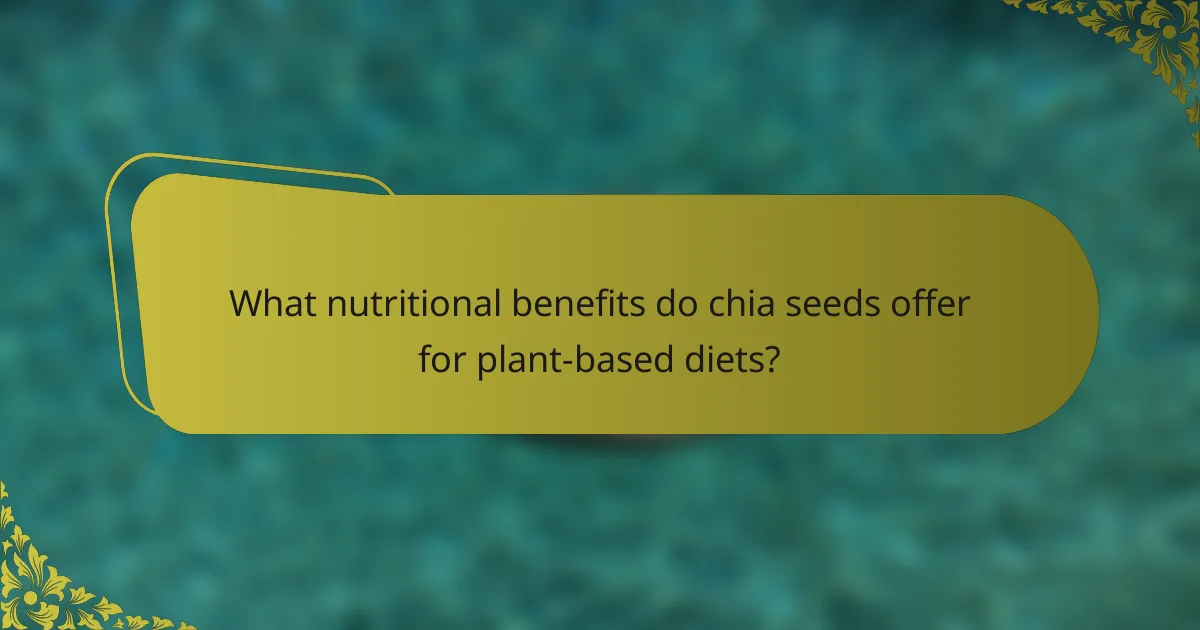Chia seeds are a powerhouse of nutrition, offering essential omega-3 fatty acids, fibre, and protein for plant-based diets. They support heart health, digestive health, and bone strength. This article explores their nutritional value, versatile uses in meals, common misconceptions, and sustainable cultivation practices. Discover how to easily incorporate chia seeds into your daily diet for enhanced health benefits.

What nutritional benefits do chia seeds offer for plant-based diets?
Chia seeds offer numerous nutritional benefits for plant-based diets, including high levels of omega-3 fatty acids, fibre, protein, and essential minerals. These seeds contain 5 grams of protein per ounce, 11 grams of fibre, and are rich in calcium, magnesium, and phosphorus. As a result, they support heart health, digestive health, and bone strength. Chia seeds are also a unique source of antioxidants, helping to combat oxidative stress. Their versatility allows easy incorporation into smoothies, porridge, or baked goods, enhancing the nutritional value of plant-based meals.
How do chia seeds compare to other plant-based protein sources?
Chia seeds provide a unique balance of protein, fibre, and omega-3 fatty acids compared to other plant-based protein sources. They contain approximately 4 grams of protein per 28 grams, which is lower than sources like quinoa and lentils but offers distinct health benefits.
Chia seeds are rich in antioxidants, aiding in inflammation reduction and heart health. Unlike many other plant proteins, they can absorb up to 12 times their weight in water, promoting hydration and satiety. This unique attribute makes them versatile for various recipes, enhancing both texture and nutritional value.
In contrast, sources like hemp seeds and soybeans offer higher protein content, with hemp providing about 9 grams of protein per 28 grams. However, chia seeds are often favoured for their ease of incorporation into meals and their additional benefits, such as supporting digestive health due to their high fibre content.
Overall, chia seeds stand out in the plant-based protein landscape due to their unique nutritional profile and health-promoting properties, making them an excellent choice for those pursuing a balanced diet.
Which vitamins and minerals are abundant in chia seeds?
Chia seeds are rich in several essential vitamins and minerals, including calcium, magnesium, phosphorus, and iron. These nutrients support bone health, muscle function, and overall metabolic processes. Additionally, chia seeds provide a significant amount of antioxidants, which contribute to their health benefits.
What is the fibre content of chia seeds and how does it support digestion?
Chia seeds contain approximately 34 grams of fibre per 100 grams. This high fibre content supports digestion by promoting regular bowel movements and enhancing gut health. Soluble fibre in chia seeds absorbs water, forming a gel-like substance that aids in digestion and helps maintain satiety. Additionally, the prebiotic properties of fibre feed beneficial gut bacteria, further contributing to digestive health.
Why are omega-3 fatty acids in chia seeds important for health?
Omega-3 fatty acids in chia seeds are vital for health due to their anti-inflammatory properties and support for heart and brain function. These essential fats contribute to reducing the risk of chronic diseases, improving cognitive performance, and enhancing overall well-being. Chia seeds contain alpha-linolenic acid (ALA), a plant-based omega-3 fatty acid, providing approximately 5 grams per ounce. Regular consumption can help maintain healthy cholesterol levels and promote cardiovascular health.

How can chia seeds be incorporated into daily meals?
Chia seeds can be easily incorporated into daily meals in various ways. They can be added to smoothies for a nutrient boost, mixed into porridge for added texture, or used as a thickening agent in sauces and soups.
1. Smoothies: Blend chia seeds into your favourite smoothie for extra fibre and omega-3 fatty acids.
2. Porridge: Stir chia seeds into porridge to enhance its nutritional profile and create a satisfying breakfast.
3. Salads: Sprinkle chia seeds on salads for a crunchy texture and additional protein.
4. Baking: Incorporate chia seeds into baked goods like muffins or bread for added nutrition.
5. Puddings: Mix chia seeds with plant-based milk and sweetener to create a delicious pudding.
6. Soups: Use chia seeds to thicken soups and stews while boosting their health benefits.
What are popular recipes featuring chia seeds?
Chia seeds are popular in various recipes due to their versatility and health benefits. Common recipes include chia pudding, smoothies, energy bars, salads, and baked goods.
Chia pudding combines chia seeds with plant-based milk and sweeteners, often topped with fruits. Smoothies incorporate chia seeds for added nutrition and thickness. Energy bars use chia seeds for a protein boost. Salads benefit from chia seeds’ texture and nutrient profile. Baked goods, such as muffins and bread, can include chia seeds for moisture and health benefits.
These recipes highlight chia seeds’ unique attribute of being a rich source of omega-3 fatty acids and fibre, making them ideal for plant-based diets.
How can chia seeds be used as a thickening agent in cooking?
Chia seeds can be used as a thickening agent by absorbing liquid and forming a gel-like consistency. When mixed with water or other liquids, they swell and create a thick texture, making them ideal for smoothies, puddings, and sauces. This property is due to their high soluble fibre content, which can absorb up to 12 times their weight in liquid. Additionally, chia seeds are rich in omega-3 fatty acids, protein, and antioxidants, enhancing the nutritional value of dishes while acting as a natural thickener.
Which forms of chia seeds are most effective for consumption?
Whole chia seeds, ground chia seeds, and chia seed oil are the most effective forms for consumption. Whole seeds provide fibre and protein, while ground seeds enhance nutrient absorption. Chia seed oil offers healthy fats, particularly omega-3 fatty acids. Each form supports a plant-based lifestyle with unique benefits.

What unique health benefits do chia seeds provide?
Chia seeds provide unique health benefits, including high omega-3 fatty acid content, which supports heart health. They are rich in fibre, promoting digestive health and aiding in weight management. Additionally, chia seeds contain antioxidants, which combat oxidative stress and inflammation. Their ability to absorb water can enhance hydration and prolong energy release, making them beneficial for endurance activities.
How can chia seeds aid in weight management?
Chia seeds can aid in weight management by promoting satiety and reducing overall calorie intake. Their high fibre content, approximately 34 grams per 100 grams, expands in the stomach, creating a feeling of fullness. This can help curb appetite and prevent overeating. Additionally, chia seeds provide healthy omega-3 fatty acids, which may support metabolic health. Including chia seeds in a balanced diet can enhance weight loss efforts by integrating nutrient-dense, low-calorie foods.
What role do chia seeds play in heart health?
Chia seeds significantly contribute to heart health by providing omega-3 fatty acids, fibre, and antioxidants. These nutrients help reduce inflammation, lower cholesterol levels, and improve overall cardiovascular function. Omega-3 fatty acids, particularly alpha-linolenic acid (ALA), are essential for maintaining heart health. A study indicated that regular consumption of chia seeds can lead to improved lipid profiles, promoting better heart health outcomes.
Why are chia seeds considered beneficial for skin health?
Chia seeds are beneficial for skin health due to their high omega-3 fatty acid content, which helps maintain skin hydration and elasticity. They also contain antioxidants that protect against skin damage. Rich in fibre, chia seeds support digestion, promoting a clearer complexion. Their unique attribute includes the ability to absorb water, forming a gel that can help keep skin moisturised.

Which common misconceptions exist about chia seeds?
Many misconceptions about chia seeds suggest they are a magic solution for weight loss or that they contain high amounts of protein. In reality, chia seeds are nutrient-dense but should be part of a balanced diet. One common myth is that they can replace all sources of omega-3 fatty acids; however, they contain ALA, which the body must convert to EPA and DHA. Another misconception is that chia seeds can be consumed dry; they must be soaked to prevent digestive issues. Lastly, some believe chia seeds are a complete protein, but they lack certain essential amino acids.
What are the myths surrounding the protein content of chia seeds?
Many myths exist about the protein content of chia seeds, often overstating their protein value. Chia seeds contain about 17 grams of protein per 100 grams, which is significant for a plant-based source. However, they are not a complete protein as they lack sufficient amounts of certain essential amino acids. This misconception can lead to unrealistic expectations regarding their role in meeting protein needs. Additionally, chia seeds are often praised for their fibre and omega-3 fatty acid content, which can overshadow their actual protein contribution.
How do chia seeds affect blood sugar levels?
Chia seeds can help stabilise blood sugar levels due to their high fibre content. The soluble fibre in chia seeds forms a gel-like substance in the stomach, slowing digestion and the absorption of sugars. This process can lead to more gradual increases in blood sugar levels, which is beneficial for individuals managing diabetes or insulin sensitivity. Additionally, chia seeds contain omega-3 fatty acids, which may also contribute to improved insulin sensitivity.

What are the potential downsides of consuming chia seeds?
Chia seeds may cause digestive issues, allergic reactions, or nutrient absorption interference. High fibre content can lead to bloating or gas if consumed excessively. Some individuals may experience allergic reactions, though this is rare. Additionally, chia seeds can absorb water and expand, potentially leading to choking hazards if not consumed properly.
Are there any allergies or intolerances associated with chia seeds?
Chia seeds are generally safe, but some individuals may experience allergies or intolerances. Symptoms can include digestive issues or allergic reactions like rashes. The unique protein profile of chia seeds can occasionally trigger sensitivities in those with nut allergies. Always consult a healthcare professional if you suspect an allergy.
What should be considered regarding chia seeds’ high fibre content?
Chia seeds’ high fibre content aids digestion and promotes satiety. A single ounce contains about 11 grams of fibre, which is 42% of the daily recommended intake. This fibre supports gut health by acting as a prebiotic, fostering beneficial bacteria. Additionally, the soluble fibre in chia seeds can help regulate blood sugar levels, making them a valuable addition to a balanced diet.

How do chia seeds fit into sustainable eating practices?
Chia seeds contribute to sustainable eating by being nutrient-dense, water-efficient, and requiring minimal land for cultivation. They provide essential omega-3 fatty acids, fibre, and protein, making them a valuable addition to plant-based diets. Chia seeds can thrive in diverse climates, reducing reliance on intensive farming practices. Their cultivation supports soil health and biodiversity, aligning with sustainable agricultural principles.
What environmental benefits are associated with chia seed farming?
Chia seed farming offers significant environmental benefits, including soil health improvement and biodiversity enhancement. These seeds require minimal water, making them sustainable in arid regions. They also contribute to carbon sequestration, reducing greenhouse gases. Additionally, chia plants attract pollinators, supporting local ecosystems.
How do chia seeds contribute to a balanced plant-based diet?
Chia seeds significantly enhance a balanced plant-based diet by providing essential nutrients. They are rich in omega-3 fatty acids, fibre, and protein, contributing to heart health and digestive wellness. The unique attribute of chia seeds is their ability to absorb liquid, forming a gel-like consistency that aids hydration. Additionally, they contain antioxidants, which support overall health and reduce inflammation. Incorporating chia seeds into meals can help achieve a well-rounded nutritional profile.

What expert tips can enhance the use of chia seeds in meals?
To enhance the use of chia seeds in meals, consider these expert tips. Incorporate chia seeds into smoothies for added fibre and omega-3 fatty acids. Use them as a thickening agent in soups or sauces, enhancing texture without altering flavour. Soak chia seeds in water or plant-based milk to create a gel-like consistency, perfect for puddings or as an egg substitute in baking. Combine them with porridge or yoghurt for a nutritious breakfast boost. Lastly, sprinkle chia seeds on salads or roasted vegetables to increase nutritional value and add a delightful crunch.
How to properly store chia seeds for maximum freshness?
Store chia seeds in an airtight container in a cool, dark place to maintain freshness. Exposure to light and moisture can degrade their quality. For long-term storage, refrigeration extends shelf life up to two years. Always check for rancidity before use, as fresh seeds have a nutty aroma.
What are best practices for preparing chia seeds for consumption?
Soaking chia seeds in water or plant-based milk for at least 30 minutes is the best practice for preparation. This process enhances nutrient absorption and digestion. Chia seeds can also be added directly to smoothies or porridge without soaking, but soaking improves their texture and nutrient availability. For optimal health benefits, consider consuming them daily, as they provide essential omega-3 fatty acids, fibre, and antioxidants.
What common mistakes should be avoided when using chia seeds?
Common mistakes to avoid when using chia seeds include not soaking them before consumption, which can lead to digestive issues. Additionally, using them in excess can cause bloating due to their high fibre content. Not incorporating them into a balanced diet may limit their health benefits. Finally, ignoring storage recommendations can reduce their nutritional value over time.
